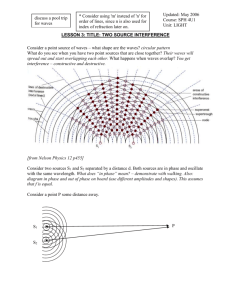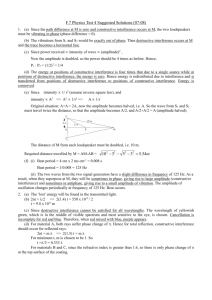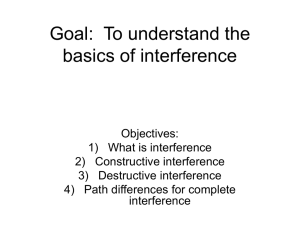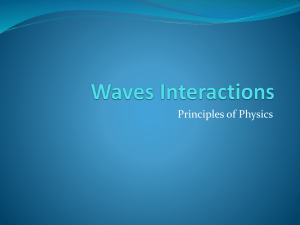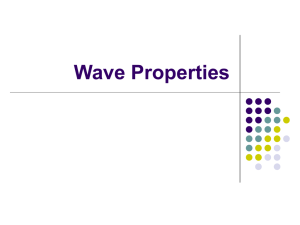Physics I - Rose
advertisement
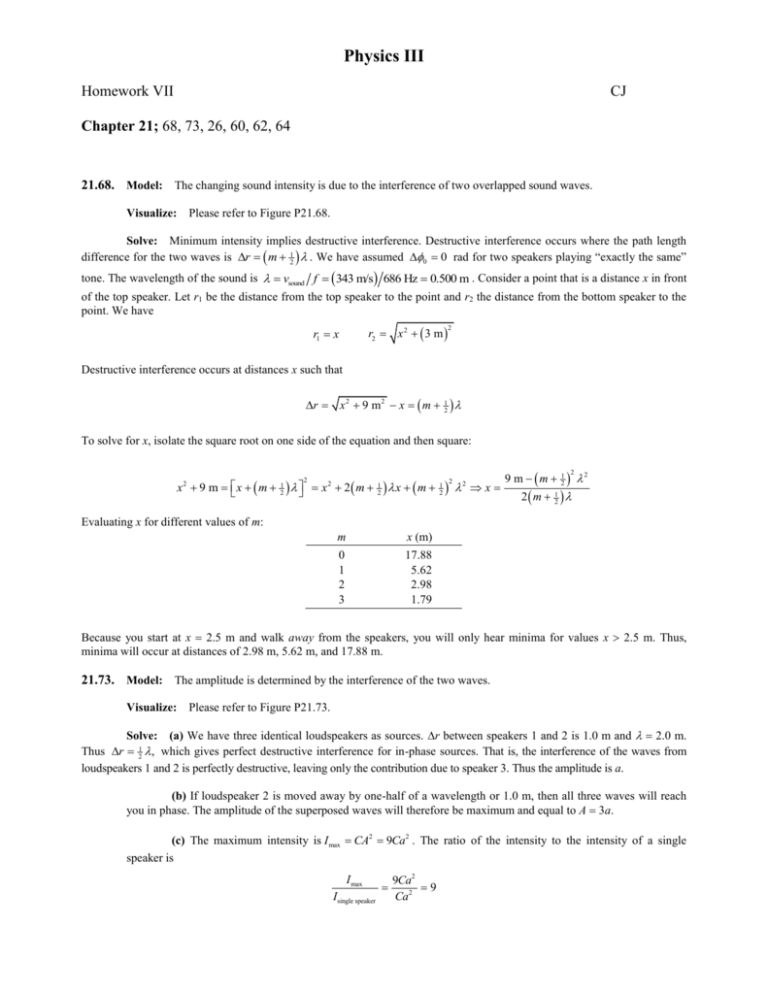
Physics III Homework VII CJ Chapter 21; 68, 73, 26, 60, 62, 64 21.68. Model: The changing sound intensity is due to the interference of two overlapped sound waves. Visualize: Please refer to Figure P21.68. Solve: Minimum intensity implies destructive interference. Destructive interference occurs where the path length difference for the two waves is r m 21 . We have assumed 0 0 rad for two speakers playing “exactly the same” tone. The wavelength of the sound is vsound f 343 m/s 686 Hz 0.500 m . Consider a point that is a distance x in front of the top speaker. Let r1 be the distance from the top speaker to the point and r2 the distance from the bottom speaker to the point. We have r2 x 2 3 m r1 x 2 Destructive interference occurs at distances x such that r x 2 9 m 2 x m 1 2 To solve for x, isolate the square root on one side of the equation and then square: x 2 9 m x m 1 2 x 2 2 m 2 1 2 x m 1 2 2 2 x 9 m m 2 m 1 2 1 2 2 2 Evaluating x for different values of m: m x (m) 0 1 2 3 17.88 5.62 2.98 1.79 Because you start at x 2.5 m and walk away from the speakers, you will only hear minima for values x 2.5 m. Thus, minima will occur at distances of 2.98 m, 5.62 m, and 17.88 m. 21.73. Model: The amplitude is determined by the interference of the two waves. Visualize: Please refer to Figure P21.73. Solve: (a) We have three identical loudspeakers as sources. r between speakers 1 and 2 is 1.0 m and 2.0 m. Thus r 21 , which gives perfect destructive interference for in-phase sources. That is, the interference of the waves from loudspeakers 1 and 2 is perfectly destructive, leaving only the contribution due to speaker 3. Thus the amplitude is a. (b) If loudspeaker 2 is moved away by one-half of a wavelength or 1.0 m, then all three waves will reach you in phase. The amplitude of the superposed waves will therefore be maximum and equal to A 3a. (c) The maximum intensity is I max CA2 9Ca2 . The ratio of the intensity to the intensity of a single speaker is I max Isingle speaker 9Ca2 9 Ca2 21.26. Visualize: Please refer to Figure Ex21.26. Solve: (a) The circular wave fronts emitted by the two sources show that the two sources are in phase. This is because the wave fronts of each source have moved the same distance from their sources. (b) Let us label the top source as 1 and the bottom source as 2. Since the sources are in phase, 0 0 rad. For the point P, r1 3 and r2 4. Thus, r r2 r1 4 3 . The phase difference is 2r 2 2 This corresponds to constructive interference. For the point Q, r1 27 and r2 2. The phase difference is 2r 2 23 3 This corresponds to destructive interference. For the point R, r1 25 and r2 27 . The phase difference is 2 2 This corresponds to constructive interference. r1 r2 r 3 3 2 P Q 7 2 4 2 R 5 2 7 2 C/D C D C 21.60. Model: Constructive or destructive interference occurs according to the phases of the two waves. Solve: The phase difference between the sound waves from the two speakers is 2 x 0 With no delay between the two signals, 0 0 rad and 2 2.0 m v f 340 Hz 2 2.0 m 4 rad 340 m/s According to Equation 21.22, this corresponds to constructive interference. A delay of 1.47 ms corresponds to an inherent phase difference of 2 0 1.47 ms rad 2 f 1.47 ms rad 2 1.47 ms 340 Hz rad rad T The phase difference between the signals is then x 2 0 4 rad rad 5 rad Thus, the interference along the x-axis will be perfect destructive. 21.62. Model: Reflection is maximized for constructive interference of the two reflected waves, but minimized for destructive interference. Solve: (a) Constructive interference of the reflected waves occurs for wavelengths given by Equation 21.32: m Thus, 1 1420 nm, 2 1 2 2nd 2 1.42 500 nm 1420 nm m m m 1420 nm 710 nm, 3 473 nm, 4 355 nm, is in the visible range. (b) For destructive interference of the reflected waves, Only the wavelength of 473 nm Thus, 1 2 1420 nm 2840 nm, 2 2 3 2 1.42 500 nm 1420 nm 2nd 1 m 2 m 21 m 21 1420 nm 947 nm , 3 568 nm , 4 406 nm, The wavelengths of 406 nm and 568 nm are in the visible range. (c) Beyond the limits 430 nm and 690 nm the eye’s sensitivity drops to about 1 percent of its maximum value. The reflected light is enhanced in blue (473 nm). The transmitted light at mostly 568 nm will be yellowish green. 21.64. Solve: (a) The intensity of reflected light from the uncoated glass is I 0 Ca2 , where a is the amplitude of the reflected light. We will assume that the amplitude of the reflected light from both the bottom and the top of the coated film is a. The interference of the two reflected waves determines the amplitude of the resultant wave which is given by x A 2a cos 2 where 2 0 coat With 0 0 rad, x 2d , and coat air n , we have A 2a cos 2 2d air n 803.5 nm 0 rad 4 dn 4 92 nm 1.39 1607 nm I 803.5 nm 2 803.5 nm I CA2 C4a2 cos2 I 4cos 0 (b) The values of I I 0 at 400, 450, 500, 550, 600, 650, and 700 nm are 0.719, 0.182, 0.005, 0.048, 0.211, 0.431, and 0.674 respectively. (c)
